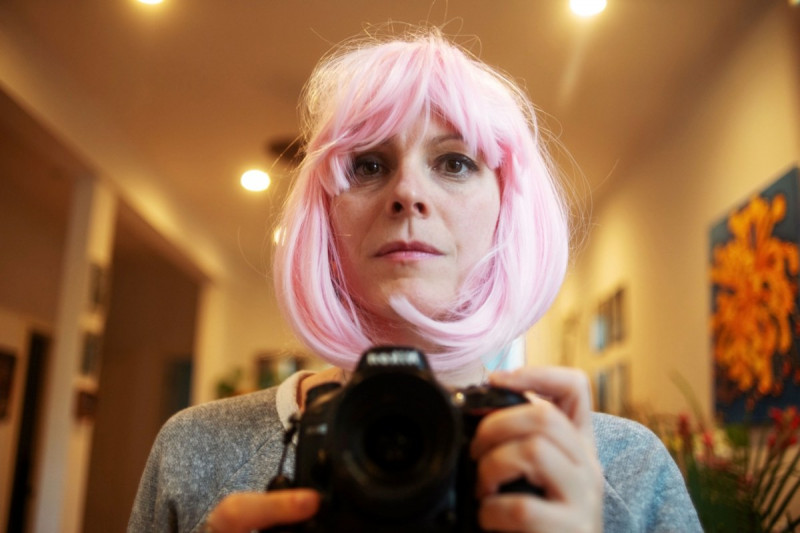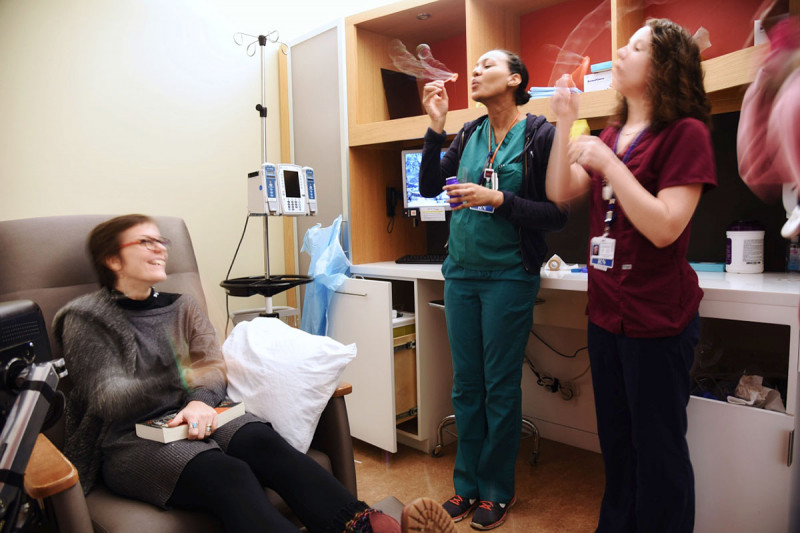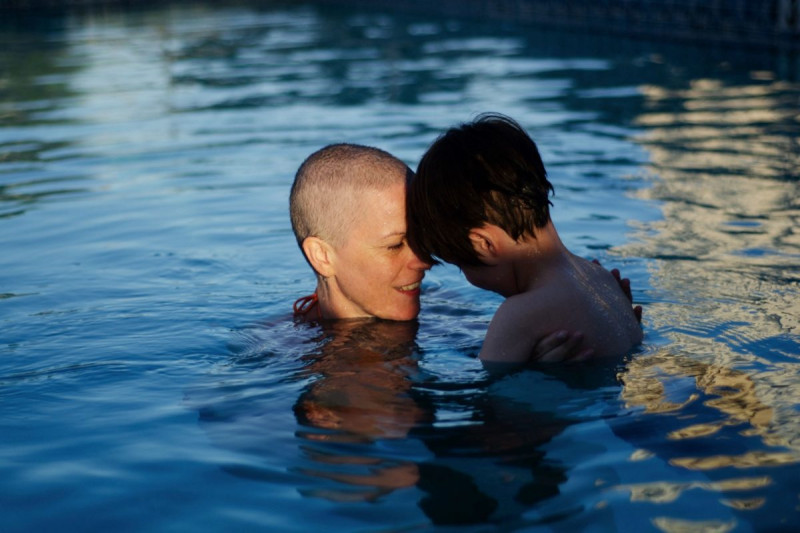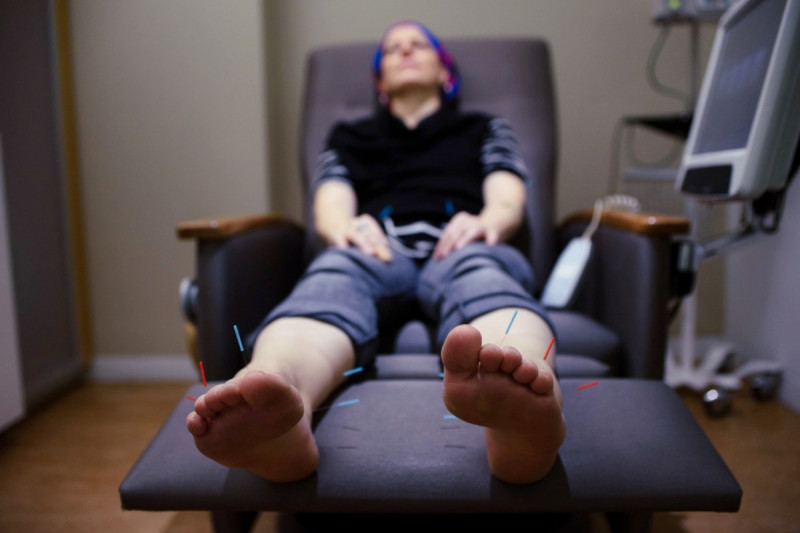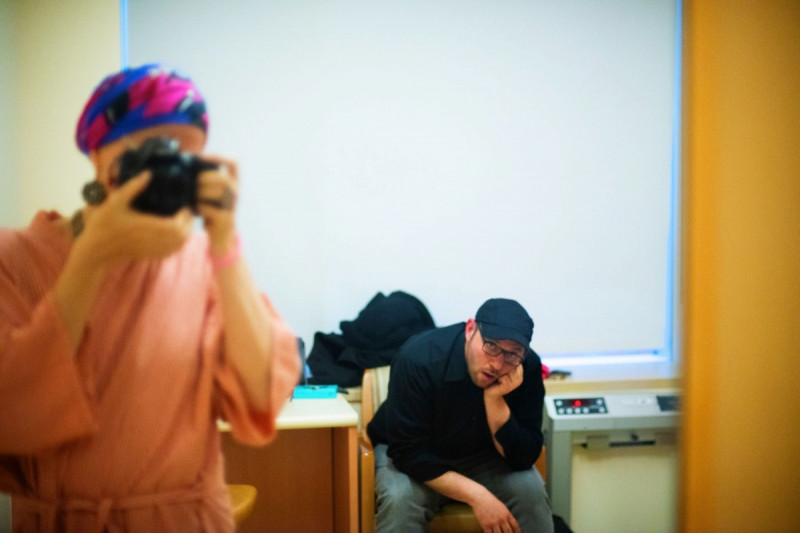In 2016, Brooklyn photographer Anna Rathkopf found a lump in her breast. She was otherwise healthy and had no family history of breast cancer, so she was shocked when she learned that it was cancerous. Anna and her husband, Jordan, who is also a photographer, documented her experience in photos. The series has garnered attention from media mogul Arianna Huffington.
Anna Rathkopf, breast cancer survivor: I have a friend who was diagnosed with breast cancer when she was 37. She had no risk factors, so when it happened to her, I realized it could happen to anybody. I started to pay more attention to my body. I went to my gynecologist when I was 36 and asked him about a mammogram. He told me, “You have no family history, and you’re healthy. You don’t have to worry about it.” Six months later, on my 37th birthday, I found my lump.
Jordan Rathkopf, Anna’s husband: I was nervous because my mom had breast cancer. My sister is an oncologist at MSK.
Anna: Jordan’s sister said to go get it checked as soon as possible.
Anna and Jordan made an appointment for a consultation at Memorial Sloan Kettering. They met with breast surgeon Alexandra Heerdt.
Anna: I came for a mammogram and an ultrasound because I had already found a lump. The mammogram didn’t pick up anything, which I learned can happen with younger women because we typically have denser breast tissue. But the ultrasound picked it up, so they did a biopsy that day.
Alexandra Heerdt, surgeon: Women who have dense breast tissue may have a lump that won’t be seen on a mammogram. That’s why we investigate all lumps fully with different imaging techniques. This includes ultrasound. We don’t presume that it is fine simply because it is not seen on a mammogram.
The results were a shock: stage I, triple positive breast cancer. This type of breast cancer is rare and especially challenging to treat. With triple positive breast cancers, tumors are estrogen-receptive positive, progesterone-receptive positive, and HER2 positive.
Anna: We went from thinking about having another child to talking about survival rates.
Dr. Carol Lee answers questions about the concept of breast density and what women with dense breast tissue should know.
Dr. Heerdt: I was quite surprised by her diagnosis. She had a mass that felt like a noncancerous lesion called a fibroadenoma.
Anna: Dr. Heerdt was very sweet and reassuring. I just thought, Get it out of me. I don’t want it. My body gave me a birthday present, though not a happy one. But had I gotten it next year, it might have been worse because the disease might have been further along.
Jordan: The lump was very small, but it exhibited aggressive characteristics. After another analysis, Dr. Heerdt recommended starting chemotherapy. We got the dream team combo of Drs. Heerdt and [Chau] Dang. Dr. Dang is an expert in treating people with breast cancer that has mutations in the gene HER2.
Chau Dang, medical oncologist: Breast cancer is an uncommon disease in young women, especially those in their 30s. Furthermore, HER2-positive breast cancer is not a common breast cancer subtype. My first impression of Anna and Jordan was how young they were, with a small child, to be dealing with breast cancer. This disease affects more than the patient; it affects the entire family. However, it was immediately clear to me how loving Jordan was. I felt that Anna would be able to undergo treatment and endure the side effects with Jordan by her side.
After Anna had a lumpectomy at the Josie Robertson Surgery Center, she and Jordan met with Dr. Dang at MSK Westchester to discuss their next steps.
Dr. Dang: Anna had a small cancer, but HER2-positive disease is aggressive. Although her outcome might have been good with trastuzumab (Herceptin®), an anti-HER2 drug, I thought we should couple it with chemotherapy. This combination of chemotherapy and trastuzumab was approved by the US Food and Drug Administration based on a practice-changing study of more than 400 people with mostly stage I HER2-positive breast cancer. Overall, the participants’ three-year outcome of being free of recurrence was greater than 98 percent. And those numbers remain high today.
Jordan: Dr. Dang said if we didn’t opt for the combination, we’d still have an incredibly favorable outcome. But in the world of cancer care, when you have numbers that good, you want to make that an option.
Anna: I decided to go with chemo.
Jordan: We trusted our doctors with everything. They were both so kind and compassionate.
Anna’s next course of breast cancer treatment involved 12 doses of chemotherapy, 12 doses of trastuzumab, and 30 days of radiation.
Anna: I remember thinking, 12 doses isn’t that bad, but once you’re in it, it’s a lot. It was basically a full year of treatment. I’m also taking tamoxifen (Nolvadex®) for the next nine years. This medicine is used to keep breast cancer from coming back.
Anna and Jordan documented their experience in a photo essay published on Arianna Huffington’s wellness website, Thrive Global, and in print by Click magazine. A version of the photo essay is on the couple’s website.
Jordan: It’s so hard to express what you’re going through, so the photos showed things that were hard to put into words.
Anna: I was taking a lot of self-portraits in dressing rooms. I felt it gave me an opportunity to use my creativity, to get my mind off everything.
Jordan: I worked in marketing and PR for nonprofits, so I knew how much raising awareness could make an impact on educating others about things that they may not be aware of. I felt like we had a responsibility to use our experience to show other young people that cancer can happen to anyone, and to encourage them to get checked by a doctor if they find something that isn’t normal.
During treatment, Anna became close with one of her nurses, Asha Monge. Ms. Monge is a nurse at MSK’s Brooklyn Infusion Center.
Asha Monge, nurse: One day, I asked Anna about her son and how she chose his name. I told her I was pregnant and having difficulty choosing a name. She was so happy and excited for me, as if we were longtime friends. Whenever I saw Anna after that, before I could ask her how she was doing, she would ask how I was feeling. We would chat as if we were friends having brunch.
Anna: I was always admiring the nurses — the doctors obviously, too, but it’s the nurses who do the administration of the drug. You feel sick, you’re scared, and they come with such a great attitude. They almost try to make it like you’re having a chat over coffee.
Asha: On the day of her last treatment, Anna said she would take professional pictures of the baby. I was overwhelmed by her generous offer. Ten days after my daughter was born, Anna was sitting on my couch, snuggling her in her arms. She took some really beautiful photos of us, and I am so grateful to her for capturing those moments. I am happy to hear that I helped in any small way during a difficult time for her. The best part for me, however, is to now be present for happy times with my new friend.
Anna: It felt good to have such supportive people there. Asha recently came to our son’s birthday party with her husband and their daughter.
Today, Anna is doing well and finding support through her family, her work, and MSK.
Anna: I had a bout of depression. I started seeing a psychiatrist here and went to some support groups. I also got acupuncture through the Integrative Medicine Service. I joke with Jordan that I’m trying all the different parts of MSK! I’m much better than I was last year. Depression wasn’t something I expected because I was thinking, After this, everything will be great. Then it wasn’t. My mind was catching up. But now I’m two years after diagnosis, and I just celebrated a year of clear scans.
Jordan: We wanted to tell a story we hadn’t seen much, almost like a diary: a little less tragic, a little less extreme, one that’s relatable. After giving birth, a woman’s breasts change. It is common to think a lump is nothing and to ignore it. That’s a group of women we definitely want to reach. Also, a lot of times male partners feel like they can’t speak about their feelings. I hope another guy will find this essay and see his fears shown honestly.
Anna: From everybody who saw our photo essay, one word we kept hearing was “hopeful.” We were both very happy about that because that’s what we wanted to get across.
